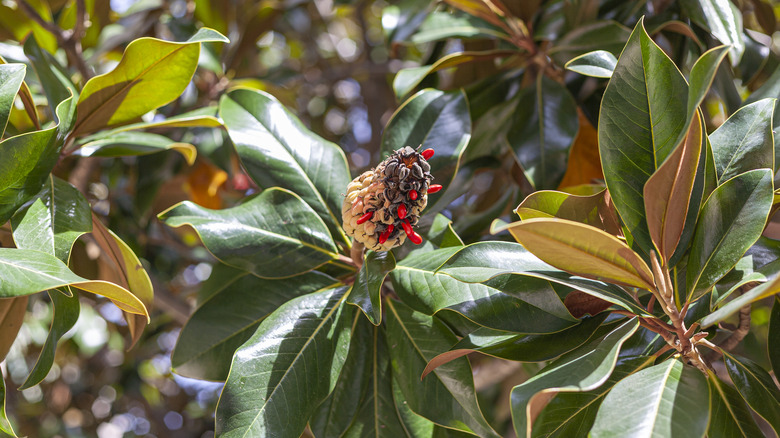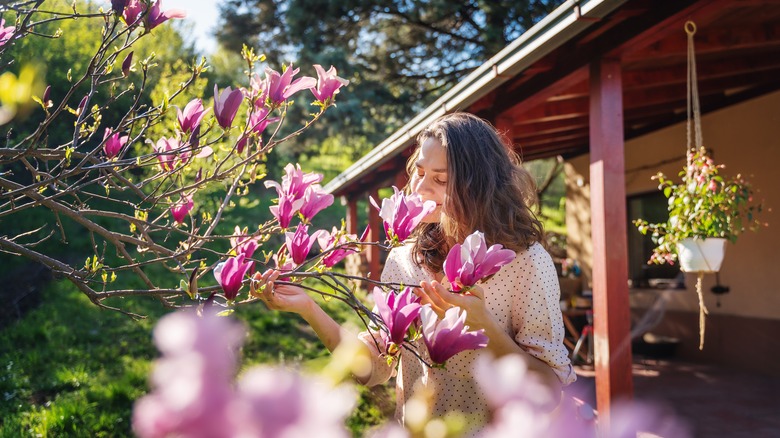Garden Trees, Shrubs & Vines
Michael Alexander Uccello
In the tranquil sanctuary of a garden, combining the dual delight of botanical beauty and the cheerful presence of wildlife is something special. If you’re a bird enthusiast with a penchant for the radiant and chipper Northern Cardinal, consider planting a magnolia tree. This magnificent tree is a symbol of the South’s enduring grace and also a cardinal magnet, thanks to its splendid foliage and flowers.
The magnolia tree, with its large, glossy leaves and fragrant blooms, is a living sculpture in any landscape. These trees come in both evergreen and deciduous varieties, providing a year-round haven for various bird species. The iconic magnolia blossoms, which range from creamy white to rich purples and pinks, can grow up to 12 inches across. The leaves have alternate textures and may be green and shiny on one side but reddish-brown and fuzzy on the other — depending on the variety. Magnolia trees represent luck, stability, nobility, and purity.
Cardinals primarily feed on seeds, fruits, and insects, which makes the magnolia tree an excellent choice. The broad leaves and dense branches offer cardinals protection from predators and the elements, while the cone-like fruit of the magnolia provides an abundant food source when insects are scarce. In winter, when food is even harder to come by, the seeds of the magnolia become particularly valuable. The dried fruit pods open to reveal red seeds that are a fantastic source of nourishment — they also offer a burst of color that matches the cardinal’s crimson feathers.
The guide to magnolia trees

Mario Elias Munoz Valencia/Getty Images
When planting a magnolia for cardinals, it’s essential to consider the tree’s mature size and the requirements for its growth. Magnolias can grow to be large, so choose a spot where it will have room to expand — both up and out. Ensure it’s a location where you can easily view the birds from a window or a porch. They thrive in well-drained soil with a slightly acidic pH. While they can adapt to various light conditions, from full sun to partial shade, they flourish with a bit of protection from the hottest afternoon rays.
There are over 200 species of magnolia! With so many to choose from, it’s essential to select a species that will thrive in your region’s climate. The Southern Magnolia (Magnolia grandiflora), with its large, white flowers and evergreen leaves, is a popular choice for those in warmer climates. For those experiencing colder seasons, the Saucer Magnolia (Magnolia soulangeana), with its stunning purple-pink blossoms, is more suitable, as it is hardy and can withstand lower temperatures.
Once established, magnolias are relatively low-maintenance. They require regular watering during their formative years and benefit from mulching to retain soil moisture and regulate temperature. Minimal pruning is needed, just enough to maintain the desired shape and remove any dead or damaged wood. It will take quite some time for your magnolia to bloom — usually around ten years. But, with patience, you’ll witness your tree mature into a stately beauty, a beacon to the vibrant cardinals.
Making your magnolia garden an avian haven

Olezzo/Shutterstock
To create a more appealing habitat for cardinals and other avian visitors, consider underplanting the magnolia with shrubs and flowers that provide additional food sources. Native plants like berry-producing shrubs and nectar-rich flowers will attract a variety of insects, providing a buffet for your feathered friends. Camellias, daffodils, calla lilies, elephant ears, ferns, and hostas are great companion plants for the magnolia. Adding a bird bath or a shallow water source near the tree will further entice cardinals to your garden.
As the seasons change, so does the magnolia’s appeal. In spring, the blossoms unfurl, providing a feast of nectar for early insects. In summer, the dense foliage offers a respite from the heat. Autumn reveals the tree’s elegant, fading leaves and the decorative fruit pods. Even in the cold heart of winter, the magnolia stands resilient, offering shelter and sustenance to birds like the cardinal. If well taken care of, most magnolia trees have a life span of 80 to 120 years. The oldest one still living and blooming is a 400-year-old saucer magnolia tree in China (via CGTN).
In the end, the magnolia is more than just a pretty tree — it is a living, breathing invitation to beauty and biodiversity in your own backyard. With the magnolia, you offer a space of habitat, a source of sustenance, and a place of year-round beauty that not only brightens the landscape but also enlivens it with the flutter and chirp of cardinal wings.



